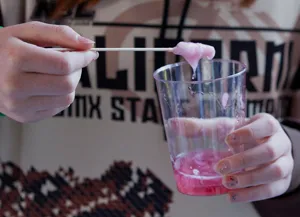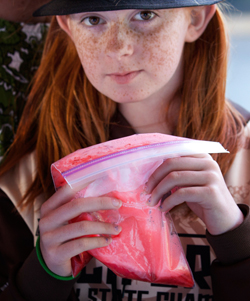
Inside Stanford Medicine - June 20th, 2011 - by Bruce Goldman
It was no ordinary day at the Clark Center. A tiny multicolored plastic bubble machine, perched at one edge of the courtyard, was spewing out soap bubbles while a song — “Mama’s Little Baby Loves Short’nin’ Bread” — dribbled from either a sound system or possibly a hidden Burl Ives doppelganger.
For a few hours in the afternoon on June 10, the headquarters for Bio-X, the university’s interdisciplinary biosciences research program, was transformed into a mini-carnival with a scientific theme, as faculty, staff and graduate students mingled with dozens of children on a play date.
For a few hours in the afternoon on June 10, the headquarters for Bio-X was transformed into a mini-carnival with a scientific theme, as faculty, staff and graduate students mingled with dozens of children on a play date.
Bio-X Kid’s Day at Clark, as it is formally known, is the brainchild of Heideh Fattaey, PhD, the program’s executive director. First held in 2005, the annual event attracted close to 300 kids this year, plus their parents. For three hours, future scientists circulated and formed clots at tables loaded with tools for exploring or appreciating bacteria, microscopy, solar energy and more.
Upon entering the scene, an adult reporter spied a table that at first looked like it might be filled with free food, as might be anticipated at a grown-up do. It turned out, however, to be topped with desiccated delights labeled "PIG UTERUS,” “DOG LIVER,” “SHEEP STOMACH,” “HORSE SCAPULA,” and “ASSORTED SKULLS.” Nothing to munch on here, but the kids didn’t care. They were already full. Full of questions.
From across the table Donna Bouley, DVM, PhD, professor of comparative medicine, lobbed a few hardballs of her own. “Do you know where your stomach is?” she asked one sharp 6-year-old. Yeah, he did.
A motley mob besieged a table offering the opportunity to extract DNA from strawberries. Why strawberries, asked the reporter (who had not exactly taken skips but had lithely squeezed his way to the front of an imaginary seniors’ line). “Because kids like strawberries,” responded Jennifer Brady, a Bio-X-funded microbiology and immunology PhD student. “Plus, strawberries are octoploid. They have eight copies of their genome in every cell, while we diploids have only two. So that’s four times as much DNA per cell.” Elementary. Everybody knows that.
“We’re made out of cells. So are strawberries,” bioengineering lab manager Charu Ramakrishnan told two small sisters named Rebecca and Claire. “We can’t take Rebecca and squish her and take out DNA from her. So we’re going to squish a strawberry!”
Rebecca, Claire and the reporter were promptly provided with strawberries confined in zip-lock bags, and instructed to pour in a shampoo-and-salt mixture and squish it all up. This procedure is designed to demonstrate that overzealous squishing of a sealed zip-lock bag’s liquid contents in the presence of an air pocket results in a phenomenon called an explosion and, later, a dry-cleaning bill.
When the squished matter was passed through a #2 Melita coffee filter and probed with a slim wooden rod, a coat of pinkish white goo materialized on its spinning, immersed tip. “That’s DNA,” said Ramaskrishnan’s 13-year-old daughter Anika, who was helping out. Not so many decades ago, the secrets of DNA lay undiscovered. Back then, kids just called it “goo.”
Rainey Townsend, age 11, who just finished fifth grade at Toyon Elementary School in San Jose, said her favorite exhibit was the strawberry table. “It was interesting that you could get so much DNA out of this little strawberry,” she said.
What does she want to be when she grows up? “Either a brain surgeon or an actor,” she said. One hopes she won’t try to combine the two careers.
Other exotic exhibits beckoned. There was a T-shirt launcher, developed by a science club at Leland High School in San Jose that could send a T-shirt flying 30 or 40 yards. Although not yet commercially available, this device has clear potential for rock concerts. There were microscopes that made the Lincoln Memorial on the back of a rusty penny, whose image was displayed on a nearby monitor, look like a bridge across a stream cutting through a snow-dotted forest. There was a robot that could high-five. There was an exhibit on magnets whose sign read, “If you cut a magnet in half, it’s a bit like cutting an earthworm in half.” (Not that we’re encouraging this behavior, the sign might have noted.) At the solar energy table, kids were enthralled by ultraviolet-sensitive beads that turned from an ivory color to orange, purple, pink and green in the courtyard’s characteristically strong sunlight.
Over the course of the afternoon, the children gawked, they grasped, they got fingerprinted and face painted. They likely learned something. And yet, they had fun.
